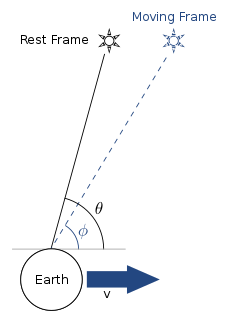
In astronomy, aberration is a phenomenon which produces an apparent motion of celestial objects about their true positions, dependent on the velocity of the observer. It causes objects to appear to be displaced towards the direction of motion of the observer compared to when the observer is stationary. The change in angle is of the order of v/c where c is the speed of light and v the velocity of the observer. In the case of "stellar" or "annual" aberration, the apparent position of a star to an observer on Earth varies periodically over the course of a year as the Earth's velocity changes as it revolves around the Sun, by a maximum angle of approximately 20 arcseconds in right ascension or declination.
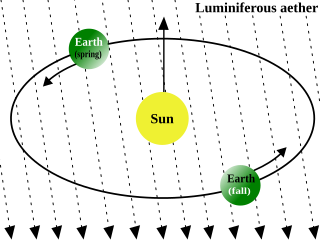
Luminiferous aether or ether was the postulated medium for the propagation of light. It was invoked to explain the ability of the apparently wave-based light to propagate through empty space, something that waves should not be able to do. The assumption of a spatial plenum of luminiferous aether, rather than a spatial vacuum, provided the theoretical medium that was required by wave theories of light.

In physics, the special theory of relativity, or special relativity for short, is a scientific theory regarding the relationship between space and time. In Albert Einstein's original treatment, the theory is based on two postulates:
- The laws of physics are invariant in all inertial frames of reference.
- The speed of light in vacuum is the same for all observers, regardless of the motion of the light source or observer.

The Michelson–Morley experiment was an attempt to detect the existence of the luminiferous aether, a supposed medium permeating space that was thought to be the carrier of light waves. The experiment was performed between April and July 1887 by American physicists Albert A. Michelson and Edward W. Morley at what is now Case Western Reserve University in Cleveland, Ohio, and published in November of the same year.
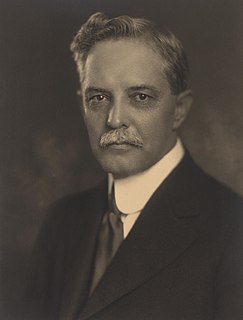
Dayton Clarence Miller was an American physicist, astronomer, acoustician, and accomplished amateur flautist. An early experimenter of X-rays, Miller was an advocate of aether theory and absolute space and an opponent of Albert Einstein's theory of relativity.
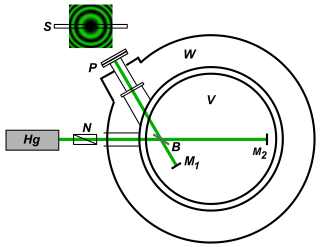
The Kennedy–Thorndike experiment, first conducted in 1932 by Roy J. Kennedy and Edward M. Thorndike, is a modified form of the Michelson–Morley experimental procedure, testing special relativity. The modification is to make one arm of the classical Michelson–Morley (MM) apparatus shorter than the other one. While the Michelson–Morley experiment showed that the speed of light is independent of the orientation of the apparatus, the Kennedy–Thorndike experiment showed that it is also independent of the velocity of the apparatus in different inertial frames. It also served as a test to indirectly verify time dilation – while the negative result of the Michelson–Morley experiment can be explained by length contraction alone, the negative result of the Kennedy–Thorndike experiment requires time dilation in addition to length contraction to explain why no phase shifts will be detected while the Earth moves around the Sun. The first direct confirmation of time dilation was achieved by the Ives–Stilwell experiment. Combining the results of those three experiments, the complete Lorentz transformation can be derived.

The Michelson interferometer is a common configuration for optical interferometry and was invented by the 19/20th-century American physicist Albert Abraham Michelson. Using a beam splitter, a light source is split into two arms. Each of those light beams is reflected back toward the beamsplitter which then combines their amplitudes using the superposition principle. The resulting interference pattern that is not directed back toward the source is typically directed to some type of photoelectric detector or camera. For different applications of the interferometer, the two light paths can be with different lengths or incorporate optical elements or even materials under test.

A beam splitter is an optical device that splits a beam of light in two. It is a crucial part of many optical experimental and measurement systems, such as interferometers, also finding widespread application in fibre optic telecommunications.
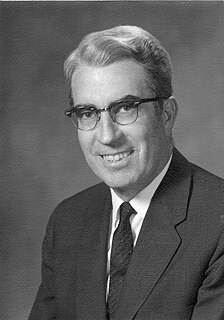
Robert Sherwood Shankland was an American physicist and historian.
Emission theory, also called emitter theory or ballistic theory of light, was a competing theory for the special theory of relativity, explaining the results of the Michelson–Morley experiment of 1887. Emission theories obey the principle of relativity by having no preferred frame for light transmission, but say that light is emitted at speed "c" relative to its source instead of applying the invariance postulate. Thus, emitter theory combines electrodynamics and mechanics with a simple Newtonian theory. Although there are still proponents of this theory outside the scientific mainstream, this theory is considered to be conclusively discredited by most scientists.
The timeline of luminiferous aether or ether as a medium for propagating electromagnetic radiation begins in the 18th century. The aether was assumed to exist for much of the 19th century—until the Michelson–Morley experiment returned its famous null result. Further experiments were in general agreement with Michelson and Morley's result. By the 1920s, most scientists rejected the aether's existence.
Special relativity is a physical theory that plays a fundamental role in the description of all physical phenomena, as long as gravitation is not significant. Many experiments played an important role in its development and justification. The strength of the theory lies in its unique ability to correctly predict to high precision the outcome of an extremely diverse range of experiments. Repeats of many of those experiments are still being conducted with steadily increased precision, with modern experiments focusing on effects such as at the Planck scale and in the neutrino sector. Their results are consistent with the predictions of special relativity. Collections of various tests were given by Jakob Laub, Zhang, Mattingly, Clifford Will, and Roberts/Schleif.

The Sagnac effect, also called Sagnac interference, named after French physicist Georges Sagnac, is a phenomenon encountered in interferometry that is elicited by rotation. The Sagnac effect manifests itself in a setup called a ring interferometer or Sagnac interferometer. A beam of light is split and the two beams are made to follow the same path but in opposite directions. On return to the point of entry the two light beams are allowed to exit the ring and undergo interference. The relative phases of the two exiting beams, and thus the position of the interference fringes, are shifted according to the angular velocity of the apparatus. In other words, when the interferometer is at rest with respect to a nonrotating frame, the light takes the same amount of time to traverse the ring in either direction. However, when the interferometer system is spun, one beam of light has a longer path to travel than the other in order to complete one circuit of the mechanical frame, and so takes longer, resulting in a phase difference between the two beams. Georges Sagnac set up this experiment in an attempt to prove the existence of the aether that Einstein's theory of special relativity had discarded.
In the 19th century, the theory of the luminiferous aether as the hypothetical medium for the propagation of light waves was widely discussed. The aether hypothesis arose because physicists of that era could not conceive of light waves propagating without a physical medium in which to do so. When experiments failed to detect the hypothesized luminiferous aether, physicists conceived explanations, which preserved the hypothetical aether's existence, for the experiments' failure to detect it.
The history of special relativity consists of many theoretical results and empirical findings obtained by Albert A. Michelson, Hendrik Lorentz, Henri Poincaré and others. It culminated in the theory of special relativity proposed by Albert Einstein and subsequent work of Max Planck, Hermann Minkowski and others.
The Michelson–Gale–Pearson experiment (1925) is a modified version of the Michelson–Morley experiment and the Sagnac-Interferometer. It measured the Sagnac effect due to Earth's rotation, and thus tests the theories of special relativity and luminiferous ether along the rotating frame of Earth.

In interferometry experiments such as the Michelson–Morley experiment, a fringe shift is the behavior of a pattern of “fringes” when the phase relationship between the component sources change.

The Fizeau experiment was carried out by Hippolyte Fizeau in 1851 to measure the relative speeds of light in moving water. Fizeau used a special interferometer arrangement to measure the effect of movement of a medium upon the speed of light.
Test theories of special relativity give a mathematical framework for analyzing results of experiments to verify special relativity.
A common-path interferometer is a class of interferometers in which the reference beam and sample beams travel along the same path. Examples include the Sagnac interferometer, Zernike phase-contrast interferometer, and the point diffraction interferometer. A common-path interferometer is generally more robust to environmental vibrations than a "double-path interferometer" such as the Michelson interferometer or the Mach–Zehnder interferometer. Although travelling along the same path, the reference and sample beams may travel along opposite directions, or they may travel along the same direction but with the same or different polarization.

















